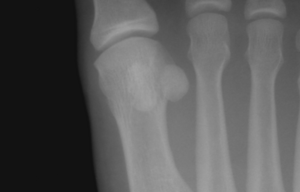Sesamoid
Original Editor - User:Patti Cavaleri
Top Contributors - Patti Cavaleri, Wendy Snyders and Kim Jackson
Description[edit | edit source]
Sesamoid bones are a type of bone that develops in some tendons where they cross the ends of long bones[1]. Sesamoids ossify during puberty and delayed ossification can indicate delayed onset of puberty.
Sesamoid bones in the human body include:
- Patella - in the quadriceps tendon at the knee
- Hallux sesamoids - medial/tibia and lateral/fibular in the flexor hallucis brevis tendon at the 1st metatarsophalangeal joint
- In the hand at the head of the 1st metacarpal - 1 in the combined tendon of the flexor pollicis brevis and abductor pollicis brevis, 1 in the tendon of the adductor pollicis
- Pisiform - in the flexor carpi ulnaris tendon
Function[edit | edit source]
Sesamoids protect tendons from excessive wear and act as a spacer to change the angle of tendons before the reach their attachment point[1].
Clinical relevance[edit | edit source]
Pathology in sesamoids can be congenital or a result of trauma. Common pathology seen in sesamoid bones include:
- Bipartite or multipartite patella[2]
- Sesamoiditis
- Avascular necrosis[3]
- Fracture
Resources[edit | edit source]
References[edit | edit source]
- ↑ 1.0 1.1 Moore KL, Dalley AF, R. AAM. Clinically oriented anatomy. Philadelphia, PA: Lippincott Williams and Wilkins; 2018.
- ↑ Oohashi Y, Koshino T, Oohashi Y. Clinical features and classification of bipartite or tripartite patella. Knee Surg Sports Traumatol Arthrosc. 2010 Nov;18(11):1465-9.
- ↑ Bartosiak K, McCormick JJ. Avascular Necrosis of the Sesamoids. Foot Ankle Clin. 2019 Mar;24(1):57-67.
- ↑ RegisteredNurseRN. Types of Bones Anatomy: Long, Short, Flat, Irregular, Sesamoid, Sutural. Available from: https://www.youtube.com/watch?v=YPiEc8OZAKU [last accessed 21/2/2022]







